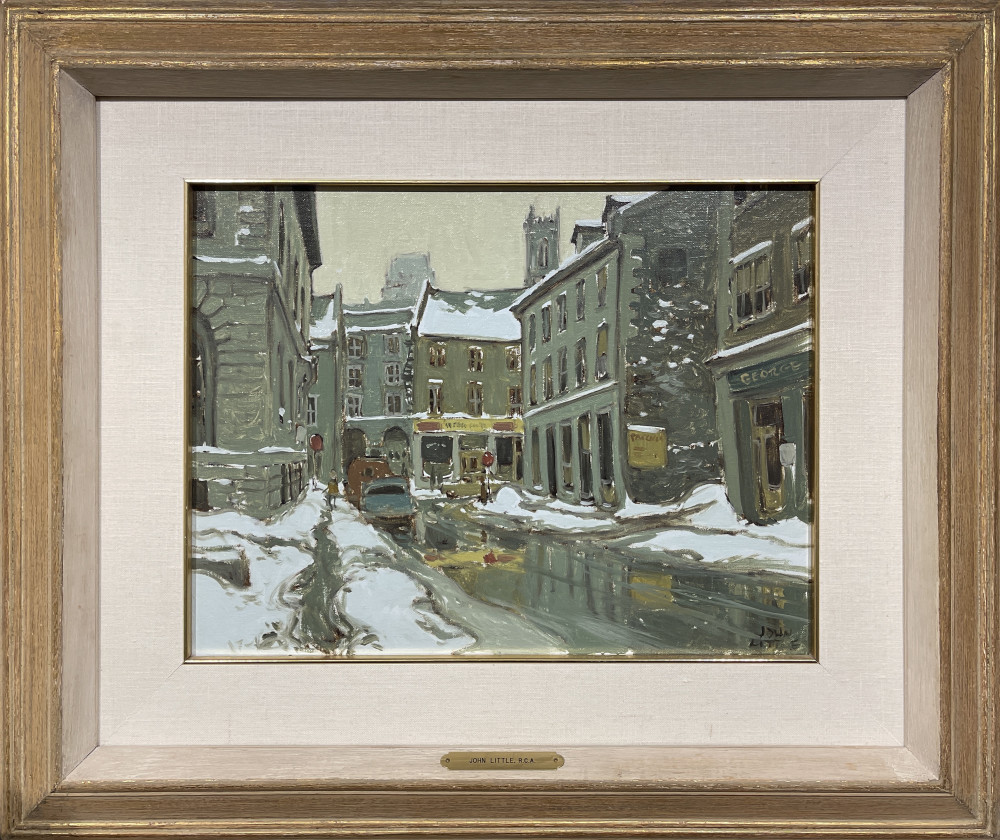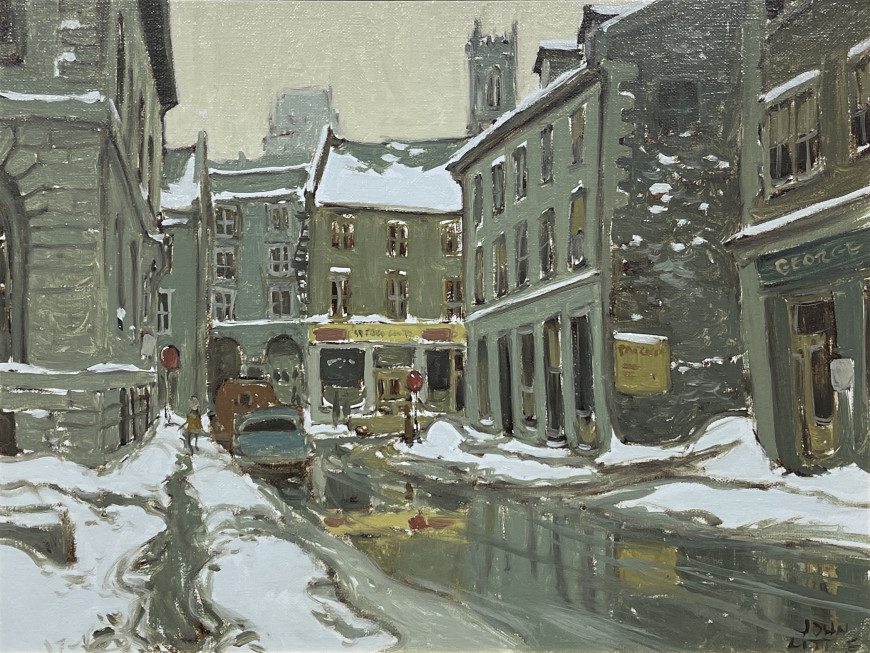-
Œuvres d'art
John LittlePlace Royale, Rue St. Paul, Montreal, 19651928-2024Oil on canvas board12 x 16 in
30.5 x 40.6 cmSoldInscriptions
signed, 'JOHN/LITTLE' (lower right); titled, signed and dated by the artist, 'PLACE ROYALE / RUE ST. PAUL / MONTRÉAL / JOHN LITTLE / '65' (verso, upper centre)Provenance
Galerie Walter Klinkhoff Inc., Montreal.
Private collection, Montreal.
John Little has always been a believer in conserving the urban core as a place not only to work but also to live. Within the context of post WWII suburbanization and commercial development of the city centre came wholesale demolition of some areas of the inner city to make way for new and larger roads and office complexes. Little thought the preservation of these neighbourhoods an important part of the fabric of the city. A shy and gentle man, he was ill-equipped to halt this destruction of our heritage. At the height of this popular bulldozer policy to what was touted as urban renewal, in 1961 to photographer Don Newlands, an acquaintance of his at MacLean's Magazine, Little said, "If we knock down all our old buildings and neighbourhoods we'll become a people without a past”. “My motto is, new plumbing for old buildings... I don't mean to preserve everything but there is so much in this city worth preserving" he continued [1]. With pencils and paper, camera and film and ultimately paint on canvas, what Little was able to do was capture these snippets of urban life as we knew it before the wrecker's ball struck.
John Little is a chronicler. His paintings are a part of our collective history. They serve as an allegory for all the streets and neighbourhoods adversely affected by suburbanization and the bulldozer approach to urban renewal. In his personal style, John Little celebrates the integrity of the old. The demolition of neighbourhoods was for him like tearing out photos from the family album. Little is to our knowledge the only artist in Canada and conceivably North America to have committed an entire career to the commemoration of the downtown and the inner city neighbourhoods during this destructive period.
The years around 1965 are critical in the development of precisely the area we now refer to as Old Montreal where John Little painted this outstanding composition. The redevelopment of the central core and waterfront areas of Montreal had been studied for some years and included plans for an expressway that would have been built essentially along Rue de la Commune through the heart of the area Little painted and continuing adjacent to Place Jacques Cartier, Bonsecours Market, and eastward. This elevated expressway and its access ramps would have eviscerated the area. The salvation of Old Montreal, some might suggest, came in the reaction and subsequent response by a couple, Blanche Lemco van Ginkel and her husband Sandy (Daniel) van Ginkel. She graduated in architecture at McGill University and continued on earning a degree in city planning from Harvard. Along with her husband Sandy, who was a Dutch trained architect, they established a design and management firm in Montreal in 1957. The ensuing debates they provoked advocating the importance of the preservation of built heritage, repurposing of old buildings instead of demolishing them and replacing them with the new and Sandy's participation in the City of Montreal's planning department ultimately, “... rescued Old Montreal from Freeway developers" [2]. Montreal architect and philanthropist, Phyllis Lambert said, "He saved Old Montreal from being destroyed" [3]. The year 1964 came with the heritage protection offered by the designation of "Old Montreal" as the Arrondissement historique de Montréal. “With massive investments from the three levels of government, as well as from businesses and individuals, a lengthy rehabilitation effort began” [4]. However, despite this classification, in 1971, the Quebec government tore down several 19th century buildings to make way for a new courthouse [5].
In Little’s Place Royale, at the top of the street on the left was the business of “Sellier J E Lortie Saddler, Leather Canvas Goods ”. This is a storied company which finds its roots back in 1892 when, according to their site, Joseph Edward Lortie left Ottawa where he had apprenticed with his father in the trade of saddlery and Harness making and relocated to Montreal [6]. The evolution of their businesses and additions to their product lines to ensure prosperity in an ever changing economic environment is proudly described on their website:
Year in and year out, through boom and bust, through two World Wars, through deep
economic depression and years of prosperity, J.E. Lortie Co. Ltd. prides itself on selling
quality products made in its own Montreal plant.
Three generations of the same family have succeedingly reinvested in the upgrading of
their production facilities while always conserving a deep commitment to good
workmanship.
In today's evolving global market situation, J.E. Lortie Co. Ltd., management team and
employees enter the second century of corporate history with confidence remembering
that continued trust in basic values is the soundest guarantee of a successful future [7].
_________________________________
Footnotes:
1. Don Newlands. “A Fond Last Look at Montreal.”MacLean’s, 6 May 1961, 12-16
2. Sandra Martin. "Sandy Van Ginkel Rescued Old Montreal from Freeway Developers." The Globe and Mail, July
24, 2009. Accessed July 17, 2019. https://www.theglobeandmail.com/news/national/sandy-van-ginkel-rescued-old-
montreal-from-freeway-developers/article1200451/
3. Ibid.
4. Martin Drouin. "Old Montreal." The Canadian Encyclopedia. Accessed July 17, 2019. https://www.thecanadian
encyclopedia.ca/en/article/old-montreal.
5. "Old Montreal / Rue Notre-Dame - Three Courthouses." Old Montreal. Accessed July 17, 2019. http://www.vieux
.montreal.qc.ca/tour/etape2/eng/2text4a.htm.
6. "History of JELCO." J. E. Lortie Cie Ltée / Co. Ltd. Accessed July 18, 2019. http://jelco.ca/en/history.php.
7. Ibid.











